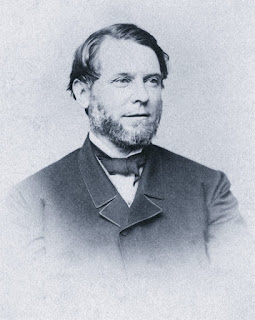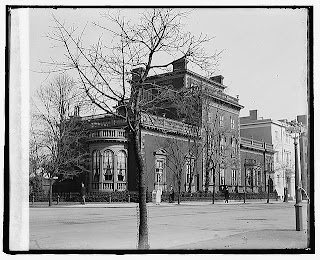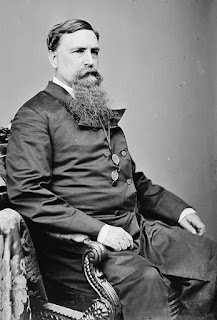William Wilson Corcoran (December 27, 1798 – February 24, 1888) was an American banker, philanthropist, and art collector who gave Washington its first art museum, the Renwick. The Gallery was designed by architect James Renwick Jr. (1818–1895), who had earlier designed the Smithsonian's Castle and St. Patrick's Cathedral in New York City. The Renwick was completed 1861 but in August of that year, the Quarter Master General’s Corps for the Union Army occupied the building to store records and uniforms, and eventually set up offices for the duration of the Civil War.
Corcoran (Corcoran street between Q street and R street NW on DuPont is named after him, its a block away from Riggs Street, which was named after his business partner) was an interesting man. He amassed a fortune by financing the Mexican War for the U.S. government through the sale of millions of dollars of government bonds.
Riggs
He retired from the banking business in 1854 with a fortune estimated to be in the area of $20 million dollars, a staggering amount of money for time. He gave away over $5 million dollars to local charities before he died in 1888. (When the average middle class income was about $2,000 a year) In 1848, Corcoran had purchased 15 acres of land for Oak Hill Cemetery, which overlooks Rock Creek Park.
He organized the Oak Hill Cemetery Company to oversee the project which was formally incorporated by Act of Congress on March 3, 1849. Corcoran paid for the construction of a Gothic Revival chapel in Oak Hill Cemetery, commonly known as the Renwick Chapel. He also established a $10,000 fund, administered by the Benevolent Society, to purchase firewood for the poor in Georgetown. He gave large amounts of cash to George Washington University, the Maryland Agricultural College, the College of William and Mary, and Washington and Lee University. He also contributed to a fund to purchase George Washington's Mount Vernon estate, after his family could no longer keep it up, and the federal government refused to purchase it.
Corcoran’s father, Thomas, was born in Limerick, Ireland, and arrived in the US in 1783 and promptly, married Hannah Lemmon, of Baltimore and in 1788, the couple settled in Georgetown, then a busy commercial port. Thomas was a shrewd and successful businessman who a magistrate, member of the levy court, postmaster, and College trustee and served two terms as mayor of Georgetown.
Corcoran was born in Georgetown and lived in or around the area most of his life. Corcoran was given a classical education with a bent on mathematical in private schools and in Georgetown College. he went to work at age seventeen, under the supervision of his two older brothers, who ran a drygoods trade a wholesale auction and commission business. The three brothers almost went bankrupt in 1823 but pulled through it.
In 1828, Corcoran was given charge of the enormous real estate holdings in the district that was then owned by the United States bank and the Bank of Columbia. (His father owned large parts of the banks)
Charles Morris
In 1835, he married (They eloped actually) Louise Amory Morris, daughter of Naval Commander Charles Morris. Louise died in 1840, leaving Corcoran to raise their three children (Harriet Louise, Louise Morris, and Charles Morris). The middle child, Louise Morris (1838-1867), was the only one to survive into adulthood.
By 1837, Corcoran was one of Washington’s most prominent broker and banker and in 1845 opened, with George Washington. Riggs, the Corcoran & Riggs Bank (Actually the took over the old United States bank located on 15th Street at New York Avenue)
A noted Southern sympathizer, Corcoran left Washington for Paris (His son-in-law George Eustis Jr., was a representative of the Confederacy.) during the Civil War and to ensure the federal government didn’t abscond with his home, located on the northeast corner of H Street and Connecticut Avenue, NW, he rented it to the French Legation which gave the property diplomatic immunity.
The government returned the building that housed his art collection to Corcoran in 1869 (Corcoran had trouble reclaiming all his property and in 1869 gave over his gallery building and much of his collection to the government.) and on February 20, 1871, the banker used the property to host a lavish ball to raise funds for the Washington Monument, whose constructed had stalled due to the war and other reasons. The event, called "the most magnificent reception ever given in the United States," was attended by President Ulysses S. Grant and included a special balcony for musicians who were accompanied by canaries singing from cages suspended from the ceiling. After extensive renovations, the building finally opened as his art gallery in 1873.
The Corcoran House was the first significant Victorian constructed in Washington. Originally built in 1828 as a three-and-one-half-story Federal residence for prominent Maryland attorney, Thomas Swann (February 3, 1809–July 24, 1883)
Swann was initially a Know-Nothing, and later a Democrat, he served as mayor of Baltimore (1856-1860), as the 33rd Governor of Maryland (1866-1869), and as U.S. Representative from Maryland's 3rd congressional district and then 4th congressional district (1869-1879). The house was later occupied by Daniel Webster. When Corcoran purchased the home, in 1849, he choose James Renwick Jr. as his architect. Renwick enlarged the house into a Renaissance-inspired mansion, which effectively introduced DC to the Italianate style. Renwick’s designs of classical window frames, cornices, and floral swags are still seen throughout the city.
William Corcoran Eustis
When Corcoran died in 1888, the house was left to his grandson, William Corcoran Eustis, (July 20, 1862 - November 24, 1921) who rented it to a succession of prominent senators and government official. Eustis, who was bon in Paris, was the son of George Eustis, Jr. (1828-1872) and Louise Morris Corcoran, (1838-1867) William Corcoran’s only daughter. George Eustis, Jr. was an lawyer and politician who was born in New Orleans.. His father was a lawyer who served as a Chief Justice of the Louisiana Supreme Court. His brother, James Biddle Eustis, was a United States Senator.
George Eustis, Jr. was a Harvard University Law School graduate, a member of Congress and later secretary to John Slidell during the Civil War and was a member of the United States House of Representatives representing Louisiana and served two terms as a member of the anti-immigration American Party. He was later Secretary of the Confederate mission in Paris. He died in Cannes, France and was buried in the Oak Hill Cemetery in D.C.
George and Louise had two sons, William Corcoran and George Peabody, and a daughter, Louise Mary, who married steeplechase horse racing trainer, Thomas Hitchcock who was one of the leading American polo players during the latter part of the 19th century and a Hall of Fame horse trainer and owner known as the father of American steeplechase horse racing.
William Corcoran Eustis was a Captain in the United States Army and the personal assistant to John J. Pershing during World War I. He was also chairman of the inauguration committee for the first inauguration of Woodrow Wilson in 1913 and laid the cornerstone for the Corcoran Gallery of Art on May 10, 1894. In 1900 he married Edith Livingston Morton (1874-1964), a daughter of Levi P. Morton, Vice President under Benjamin Harrison.
Levi Morton (above) and his home on Rhode Island Avenue and Fifteenth Street, N. W.
Together they had five children, and owned and restored the Oatlands Plantation in Leesburg, Virginia.
The Corcoran Gallery
Oatlands Plantation was established by George Carter in 1798 on 3,408 acres of farmland. It started as a wheat farm, but expanded to include other grains, sheep, a gristmill and a saw mill, and a vineyard. In 1803, Carter began construction of a Federal mansion, which he expanded in the 1820s and 1830s. He also built a terraced garden and numerous outbuildings.
Stilson Hutchins
In 1897 the Carter family sold the mansion with 60 acres to Stilson Hutchins, founder of the Washington Post newspaper, who never lived on the property. In turn, Hutchins sold Oatlands in 1903 to William Corcoran Eustis. The Corcoran House was razed in 1922 to make way for the massive neoclassical U.S. Chamber of Commerce Building which still occupies the site today.
William died on November 24, 1921 of pneumonia. His wife died in 1964. Mrs. Corcoran was also instrumental in helping to build the District of Columbia War Memorial It was the first war memorial to be erected in West Potomac Park, part of the National Mall near the Lincoln Memorial, and remains the only local District memorial on the National Mall. Their daughters donated the mansion, furnishings, and estate grounds to the National Trust under the National Trust Community Investment Corporation.
Eustis' great-granddaughter, Wendy Pepper, was a contestant on season 1 of Project Runway.













